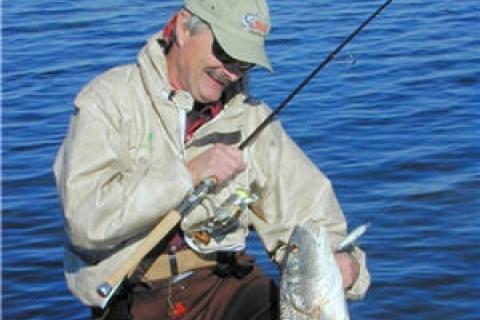
Wading is, by far, the best way to approach spooky flats species such as redfish, bonefish, permit, and sometimes snook and trout. When the fish are in water that's barely ankle deep, stealth is critical, and that gives wade-fishers a big advantage. Your profile is low and small, you can move very slowly, and you have complete control of those breathless moments when you need to stand stock-still as a fish comes by within a rod-length.
But there are a few things to know about being part of the wet-pants brigade. Here are some tips, gleaned over decades of tromping the Florida flats.
 |
| When wade fishing, a good pair of neoprene fishing waders will keep you comfortable while staying alert can help you hook up with a nice red. |
1. Get a good pair of wading booties such as the World Wide Sportsman Flats Boot. These booties have hard soles to ward of oyster shells and barnacles, soft neoprene uppers that are comfortable for long-term wear, and corrosion-proof zippers that stand up to saltwater use. The above-the-ankle design keeps out sand and shell. (If you plan an all-day wading trip, it's a good idea to wear socks inside the booties as an added protection against rubbing.)
2. Wear quick-dry shorts or a swimsuit. In an average day on the flats, you'll be in and out of the water many times. The synthetic materials don't drag a lot of water back into the boat or car and dry much quicker than cottons.
3. Wear a vest such as the Redington® Clark Fork Mesh Fly Fishing Vest to tote your extra gear, water and snacks. But don't load yourself down. After you fish a given flat a few times, you'll be able to pare down the necessary lures for that area.
4. In winter, basically anytime the water temperature gets much lower than 75, you may want to suit up in chest waders such as the RedHead Classic Series II. These neoprene waders block cold much better than thinner varieties, and because they're made of soft stretchy neoprene, they're comfortable and easy to get in and out of. The built-in boot foot means sand and shell can't get inside as it sometimes does if you wear stocking-foot waders with wading boots over them.
5. No wading shoe or boot is stingray proof. The only real defense for rays is to constantly do the "stingray shuffle," keeping your feet very close to bottom as you ease along. Rays are not aggressive, at all, so if you move slowly and stay alert, odds are minimal of getting stung. In spring, there may be dozens of little ones, barely 6 inches across, on some flats. These guys are very hard to see — they're often buried in the sand — but they pack a painful sting just like the adults, so keep a sharp eye.
6. In some areas sharks can be a hassle if you wade on the outside edge of the flats, anywhere there's three feet of water or more. Avoid them by not hanging fish on a stringer attached to your waist, by moving slowly, and keeping a sharp eye out.
7. Barracuda love to follow wade fishermen, apparently out of curiosity, but I've never seen one display aggression towards a wader. (I have had a few bonefish eaten at my feet by 'cudas, however!).
8. Move slowly and keep your eyes open for the slightest surface disturbance. Sometimes a 10-pound redfish may show only a half inch of his tail when he tips up!
- 17092 views

